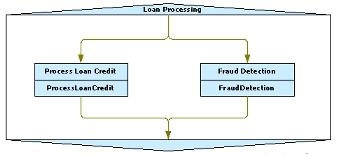|

|
Purpose
Use the Split Join shape to require that multiple subprocesses of your flow be completed before the current flow continues execution. This allows subprocesses to execute asynchronously, in parallel. For an example, see the standard flow Work-.ParallelWork.
For example, a mortgage application workflow may require that facts about the home buyers be validated, and that a title search be completed. These two tasks are unrelated and can be performed in subprocesses that proceed independently and in parallel. Other processing later in the primary flow can require that both these two subprocesses complete.
Adding a Split Join shape to a flow
Drag the Split Join shape (![]() ) onto the flow and drop it. When the Split Join Properties panel appears, complete these fields:
) onto the flow and drop it. When the Split Join Properties panel appears, complete these fields:
Field |
Description |
| Split Join Rule | |
| Name |
Enter a text name for this Split Join shape. Choose a name meaningful to application users who see this on the work item history display, the breadcrumbs control (for entry points), and the Where-Am-I? diagram. The shape name is only descriptive; it does not affect runtime execution of the flow. This name also appears inside the Split Join shape on the Diagram tab. |
| Join When.. Flows are Finished |
Choose
|
| Cost |
Optional. You can associate a cost value (in any units) with this branch. For each work item, the system computes the sum of these cost values for the specific path it takes through the flow. |
| Audit Note |
|
| Entry Point? |
Select to indicate that this Split Join shape is an entry point, which a user can return to using the breadcrumbs control or the standard flow action Previous. The default is cleared. This checkbox works with Perform harnesses that include a breadcrumbs display and with assignments that offer the Work-.Previous flow action. In other cases, the checkbox has no effect. |
| Only going back? |
This checkbox appears only when you select the Entry Point? checkbox. Select to restrict users at runtime from jumping ahead to this step without having completed the preceding steps. After having completed this step, users may jump back to it from steps that follow it.
|
Then click Apply . (To edit these shape properties after you save the Flow form, open the Diagram tab, right-click the shape, and select the Edit tab on the pop-up window.)
Connectors
1. Connect at least one incoming connector to the top of the Split Join shape. Add at least one outgoing connector to the bottom of the shape.
2. Expand the Split Join shape so that the rectangle becomes large enough to enclose the Subprocess shapes.
3. Select and drag a Subprocess shape (![]() ) for one of the subprocess to be started. Complete the Subprocess panel; then click Apply .
) for one of the subprocess to be started. Complete the Subprocess panel; then click Apply .
4. Repeat for each additional flow to be started. The Split Join shape must contain at least two called subprocesses.
5.  Add a connector from the top triangle to the top of each called subprocess. Add at least one connector from the bottom of each called flow to the bottom triangle.
Add a connector from the top triangle to the top of each called subprocess. Add at least one connector from the bottom of each called flow to the bottom triangle.
6. Complete the Connector Properties panels. If you choose Status for the connectors that start the subprocesses, you can associate a Likelihood value with each. At runtime, PRPC starts the called flows in order of greatest likelihood.

 Flow form — Editing in Visio
Flow form — Editing in Visio Optional. Select or enter the name of a Rule-Message rule to control the text of an instances added to the work item history (the "audit trail") when a flow execution completes this shape. PRPC includes a few dozen standard messages in the Work- class. (Through field value rules, you can localize the corresponding text on work item history displays. See
Optional. Select or enter the name of a Rule-Message rule to control the text of an instances added to the work item history (the "audit trail") when a flow execution completes this shape. PRPC includes a few dozen standard messages in the Work- class. (Through field value rules, you can localize the corresponding text on work item history displays. See  For maximum user flexibility, leave this checkbox unselected if your flow accepts inputs in any order. However, this approach is typically not workable for flows that contain fork and decision shapes, or that have intermediate shapes that are not entry points.
For maximum user flexibility, leave this checkbox unselected if your flow accepts inputs in any order. However, this approach is typically not workable for flows that contain fork and decision shapes, or that have intermediate shapes that are not entry points.